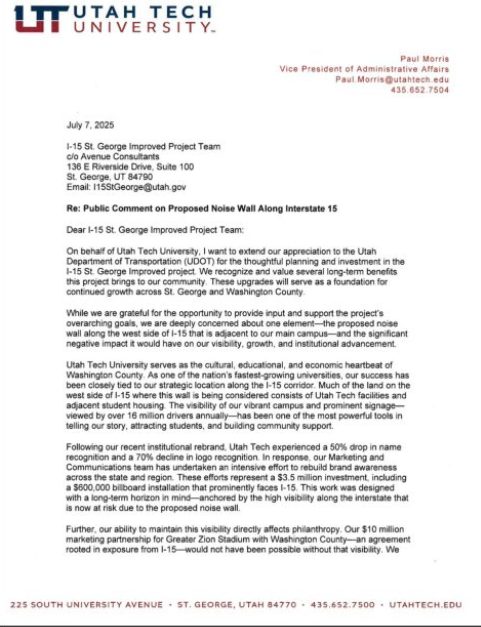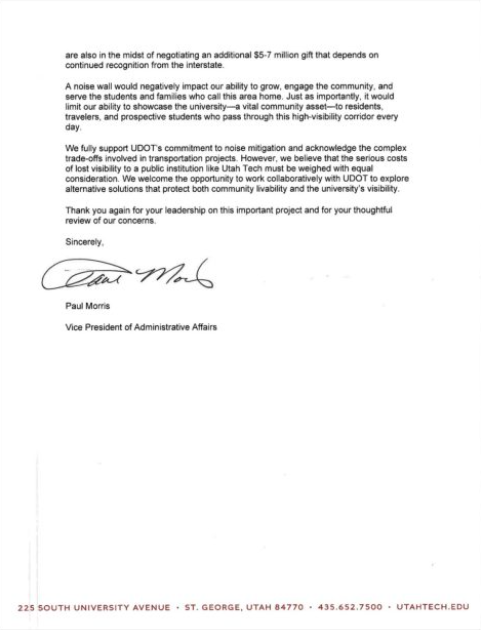Students near Interstate 15 have the chance to vote on whether a sound wall should be built to reduce noise from the freeway. The project will move forward only if 75% of voters vote yes to its build.
The Utah Department of Transportation has proposed creating a sound wall on I-15 between exits six and eight, from Bluff Street to St. George Blvd. The plan includes widening the freeway to three lanes, creating a new exit and raising the structure.
An environmental assessment was conducted by UDOT Environmental Services to evaluate freeway noise as part of the process for adding the new exit and sound wall.
UDOT reached out to Seth Gubler, director of housing and resident life, to get information about student dorms near the freeway so ballots could be sent to students, Gubler said. To move forward with the project, UDOT must receive 75% of the ballots and 75% have to be in favor of the wall. UDOT has not specified a date for when the ballots are due.
Students have to mail the ballots themselves.
Vice president of administrative affairs, Paul Morris, released a public statement on behalf of Utah Tech, writing that the sound wall will negatively affect the university.


Utah Tech relies on visibility from the freeway to attract students and gain community support, Morris said.
From the freeway, where the sound walls would be placed, drivers can see Greater Zion Stadium, billboards and several academic and student housing buildings.
Morris said a $5 million gift to the university could be affected if the university loses its visibility from the interstate.
“Following our recent institutional rebrand, Utah Tech experienced a 50% drop in recognition and a 70% decline in logo recognition,” Morris said.
The housing office was not included in discussions about the sound wall and was only informed about ballots for student apartments, Gubler said.
Gubler has not received any information or complaints about noise or the sound wall.
“No one’s reached out to me from the students nor the university. [The] communication I receive is primarily to convey information about the apartments and how they could get those ballots in students’ hands,” Gubler said.
Students living in Campus View III have not reported any noise issues, Gubler said. That building, along with Campus View II, are the closest to the interstate.
“I have been living on campus for two years now, and I haven’t heard any traffic. My room last year was closer to the road, and I still didn’t hear much then,” said McKaydee Lindwall, a freshman general studies major from Riverton.
Kelly Long, part-time housing and resident life office assistant, said she has not seen any ballots for students in the CVIII mail. Siera Butler, assistant director of resident life, said the Abby Apartments resident manager has received the ballots but does not know whether they have reached students yet.
“My bed is positioned so that my pillow is right next to the window. Because of that, I hear the freeway noise all night long. Every truck, car and motorcycle passes like it’s right outside my room,” said Michael Olsingch, a sophomore mechatronics major from Wildomar, California. Olsingch lives at Vintage at Canyonlands, an off-campus student housing complex.
Vintage at Canyonlands is one of the housing complexes located directly next to the freeway.
Getting enough rest can drastically improve academic performance by allowing the brain to store and strengthen information learned in class.
“I’m someone who really needs quiet to fall asleep, so the constant sound makes it hard to relax and get a good rest,” Olsingch said. “A sound wall would make a huge difference. Not only would it help block traffic noise, but it would also drastically improve my ability to sleep through the night.”



